View in other NatureServe Network Field Guides
NatureServe
Montana
Utah
Wyoming
Idaho
Wisconsin
British Columbia
South Carolina
Yukon
California
New York
Anicia Checkerspot - Euphydryas anicia
Native Species
Global Rank:
G5
State Rank:
S5
Agency Status
USFWS:
USFS:
BLM:
External Links
General Description
[From Ferris and Brown 1981, Scott 1986, Glassberg 2001, Guppy and Shepard 2001] Forewing 1.6-2.6 cm. Very similar in appearance to the Variegated (= Chalcedon or Variable) Checkerspot (E. chaldedona); considered by some to be a subspecies of that species. The harpe of the male genitalia is the only reliable character for identifying the species (the dorsal arm is longer than that of any other Euphydryas species, and the two arms are almost parallel). Compound eyes brown; antennal clubs luminous yellow with little if any black at base; forewings pointed; outer margin of hindwing comes to a slight point; abdomen often with white subdorsal (off-center) spots; dorsal surface of wings reddish with varying yellow and black bands (more black at higher elevations).
Phenology
One flight per year; June to early July in montane regions, mostly July at and above treeline (Scott 1986); late May to early July at low elevations in British Columbia, early July to mid-August above treeline (Guppy and Shepard 2001).
Diagnostic Characteristics
Brown compound eyes segregates Euphydryas from other checkerspot genera; larger with forewing tips more pointed than E. editha, which also lacks the off-center white abdominal spots and usually has black on the lower half of the antennal clubs; lacks the wide submarginal red-orange band of E. gillettii. The harpe of the male genitalia is the only reliable character for distinguishing E. anicia from E. chalcedona (the dorasal arm is longer than that of any other Euphydryas species, and the two arms are almost parallel); also the ventral forewing generally lacks a noticeable black band (accent) on the inner side of the postmedian row of apical white patches present on E. chalcedona.
Species Range
Montana Range
Range Descriptions
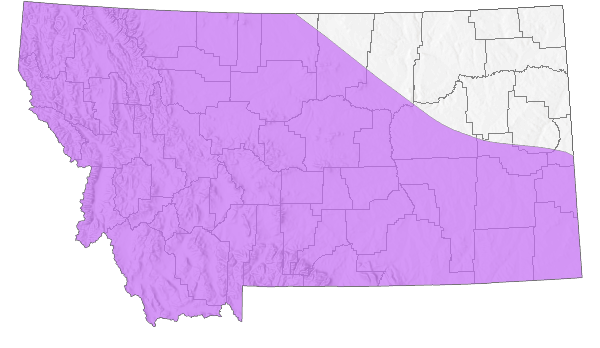
 Native
Native
Range Comments
Central Alaska south to central California, Arizona, and New Mexico west of the Great Plains, and extreme northern Mexico. Also to the Black Hills of South Dakota (Scott 1986, Glassberg 2001, Guppy and Shepard 2001). Considered common to abundant.
Observations in Montana Natural Heritage Program Database
Number of Observations: 51
(Click on the following maps and charts to see full sized version)
Map Help and Descriptions
Relative Density
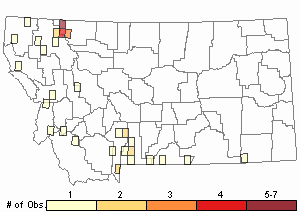
Recency
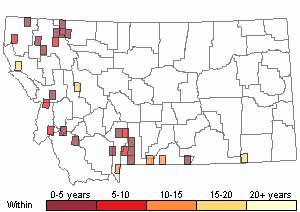
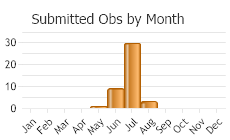
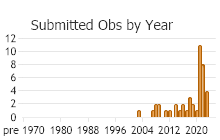
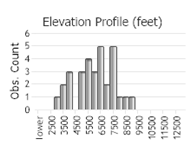 (Observations spanning multiple months or years are excluded from time charts)
(Observations spanning multiple months or years are excluded from time charts)
Migration
Non-migratory.
Habitat
Occurs at almost any elevation; in shrub-steppe, grasslands, dry conifer forest and edges, aspen parkland, canyons, montane openings, alpine tundra, mountain summits (Scott 1986, Guppy and Shepard 2001, James and Nunnallee 2011). Xeric and measic meadows, and above treeline in alpine habitat in Glacier National Park (Debinski 1993).
Food Habits
Larvae food plants include Besseya, Castilleja, Mertensia, Orthocarpus, Pedicularis, Penstemon, Plantago, and Symphoricarpos, with Collinsia in spring by overwintered larvae (Scott 1986, James and Nunnallee 2011). Adults of both sexes visit flowers for nectar, adult males also visit mud puddles.
Reproductive Characteristics
Overwintered larvae (stages L3-5) appear as early as late March and as late as late June in Washington. Eggs laid in mid August hatch in about 12 days and develop to L3 larvae in about 14 days. Number of eggs per ovariole (1/8 of total) about 150 (Ehrlich and Ehrlich 1978). Adults eclose about 12 days after pupation. Larvae overwinter at L3 instar, often in web nests on host plants, but also under rocks or litter. Larvae may diapause (overwinter) more than one year if conditions very cold or very dry. Post diapause larvae solitary, do not build nests, and feed openly on host plants. Adult males seek females throughout the day by patrolling all over habitat and/or perching especially on hilltops and exposed vegetation in clearings (Scott 1986, Guppy and Shepard 2001, James and Nunnallee 2011).
Stewardship Responsibility
References
- Literature Cited AboveLegend:
 View Online Publication
View Online Publication Debinski, D. 1993. Butterflies of Glacier National Park, Montana. Occasional Papers of the Museum of Natural History, the University of Kansas, Lawrence, Kansas. No. 159: 1-13.
Debinski, D. 1993. Butterflies of Glacier National Park, Montana. Occasional Papers of the Museum of Natural History, the University of Kansas, Lawrence, Kansas. No. 159: 1-13. Ehrlich, A.H. and P.R. Ehrlich. 1978. Reproductive strategies in the butterflies: I. Mating frequency, plugging, and egg number. Journal of the Kansas Entomological Society 51(4): 666-697.
Ehrlich, A.H. and P.R. Ehrlich. 1978. Reproductive strategies in the butterflies: I. Mating frequency, plugging, and egg number. Journal of the Kansas Entomological Society 51(4): 666-697. Ferris, C.D. and F.M. Brown (eds). 1981. Butterflies of the Rocky Mountains. Univ. of Oklahoma Press. Norman. 442 pp.
Ferris, C.D. and F.M. Brown (eds). 1981. Butterflies of the Rocky Mountains. Univ. of Oklahoma Press. Norman. 442 pp. Glassberg, J. 2001. Butterflies through Binoculars: A Field Guide to the Butterflies of Western North America. Oxford University Press.
Glassberg, J. 2001. Butterflies through Binoculars: A Field Guide to the Butterflies of Western North America. Oxford University Press. Guppy, C.S. and J.H. Shepard. 2001. Butterflies of British Columbia: including western Alberta, southern Yukon, the Alaska Panhandle, Washington, northern Oregon, northern Idaho, northwestern Montana. UBC Press (Vancouver, BC) and Royal British Columbia Museum (Victoria, BC). 414 pp.
Guppy, C.S. and J.H. Shepard. 2001. Butterflies of British Columbia: including western Alberta, southern Yukon, the Alaska Panhandle, Washington, northern Oregon, northern Idaho, northwestern Montana. UBC Press (Vancouver, BC) and Royal British Columbia Museum (Victoria, BC). 414 pp. James, D.G. and D. Nunnallee. 2011. Life histories of Cascadia butterflies. Corvallis, OR: Oregon State University Press. 447 p.
James, D.G. and D. Nunnallee. 2011. Life histories of Cascadia butterflies. Corvallis, OR: Oregon State University Press. 447 p. Scott, J.A. 1986. The butterflies of North America: a natural history and field guide. Stanford University Press, Stanford, California.
Scott, J.A. 1986. The butterflies of North America: a natural history and field guide. Stanford University Press, Stanford, California.
- Additional ReferencesLegend:
 View Online Publication
View Online Publication
Do you know of a citation we're missing? Allen, T.J., J.P. Brock, and J. Glassberg. 2005. Caterpillars in the field and garden: a field guide to the butterfly caterpillars of North America. Oxford University Press.
Allen, T.J., J.P. Brock, and J. Glassberg. 2005. Caterpillars in the field and garden: a field guide to the butterfly caterpillars of North America. Oxford University Press. Brock, J.P. and K. Kaufman. 2003. Kaufman Field Guide to Butterflies of North America. Houghton Mifflin Company, New York, NY 284 pp.
Brock, J.P. and K. Kaufman. 2003. Kaufman Field Guide to Butterflies of North America. Houghton Mifflin Company, New York, NY 284 pp. Hardesty, R.L. and D.R. Groothuis. 1993. Butterflies of the Laramie Mountains, Wyoming (Lepidoptera: Rhopalocera). Journal of Research on the Lepidoptera. 32: 107-123.
Hardesty, R.L. and D.R. Groothuis. 1993. Butterflies of the Laramie Mountains, Wyoming (Lepidoptera: Rhopalocera). Journal of Research on the Lepidoptera. 32: 107-123. Layberry, R.A., P.W. Hall, and J.D. LaFontaine. 1998. The Butterflies of Canada. University of Toronto Press. 280 pp. + color plates.
Layberry, R.A., P.W. Hall, and J.D. LaFontaine. 1998. The Butterflies of Canada. University of Toronto Press. 280 pp. + color plates. Spomer, S.M. 1985. Observations on the life history of Euphydryas anicia bernadetta Leussler (Lepidoptera: Nymphalidae) at the type locality. Journal of the Kansas Entomological Society. 58(3): 566 p.
Spomer, S.M. 1985. Observations on the life history of Euphydryas anicia bernadetta Leussler (Lepidoptera: Nymphalidae) at the type locality. Journal of the Kansas Entomological Society. 58(3): 566 p. Spomer, S.M. and J. Reiser. 1985. Observations on the life history of Occidryas anicia bernadetta Leussler at the type locality. Journal of the Lepidopterists Society. 39(1):55-57.
Spomer, S.M. and J. Reiser. 1985. Observations on the life history of Occidryas anicia bernadetta Leussler at the type locality. Journal of the Lepidopterists Society. 39(1):55-57. Stanford, R.E. and P.A. Opler. 1993. Atlas of western USA butterflies: including adjacent parts of Canada and Mexico. Unpubl. Report. Denver and Fort Collins, Colorado 275 pp.
Stanford, R.E. and P.A. Opler. 1993. Atlas of western USA butterflies: including adjacent parts of Canada and Mexico. Unpubl. Report. Denver and Fort Collins, Colorado 275 pp.
- Web Search Engines for Articles on "Anicia Checkerspot"
- Additional Sources of Information Related to "Insects"





